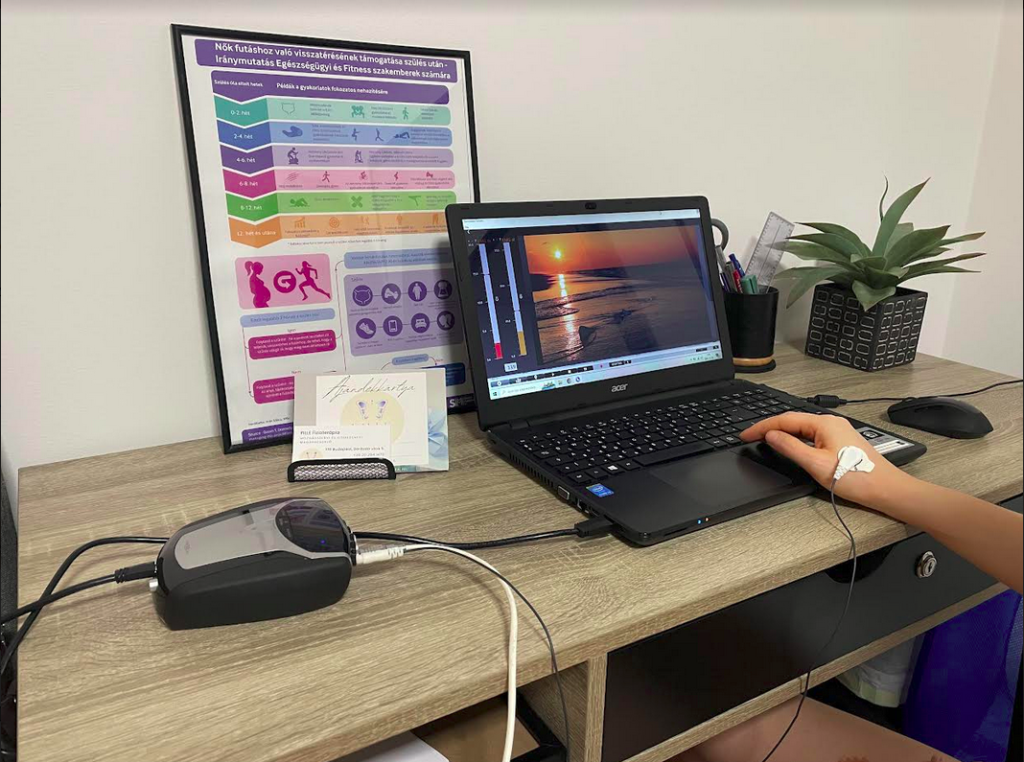EMG Pelvic Biofeedback assessment and training
Assessment:
The EMG Pelvic Biofeedback assessment provides an objective picture of the function and possible dysfunction of the pelvic floor muscles. Special equipment, sensors and monitors are used to display information on muscle activity. The passive sensors do not transmit any electrical voltage to the body. Feedback (feedback of biological signals), which is a clear indication to our brain of the electrical activity of the muscles, is displayed on the monitor. Muscle function, force and relaxation are displayed in a graph. The test is therefore used to check the function of the pelvic floor muscles. The test is performed in a painless, harmonious environment and in clothing. It can be performed in both adult women and men.
Training:
The EMG Pelvic Biofeedback training is part of pelvic physiotherapy. Through the training, the pelvic floor muscle functions – muscle strength, endurance, relaxation, coordination and reaction time – can be recovered more quickly and effectively. Along with training, consistent home practice of pelvic floor exercises is essential. Through training, the patient learns to switch off the inappropriate muscles and use the correct muscles, as the device allows the simultaneous monitoring of the function of the abdominal muscles in addition to the pelvic floor muscles.
For which conditions do we recommend testing and training?
- urinary incontinence
- faecal incontinence
- chronic constipation
- irritable bowel syndrome (IBS)
- chronic pelvic pain syndrome (CPPS)
- painful intercourse
When is it not recommend?
- in case of an anatomical and/or neurological dysfunction
- after radical surgery
- after radiotherapy
- during the first 12 weeks of pregnancy

Procedure of the assessment:
- Discussion of lifestyle and pelvic complaints, interpretation of the relevant medical findings, clarification of the purpose of the examination, objectives of therapy.
- Manual examination of abdominal muscle strength and rectus diastasis.
- Non-objective manual examination of the pelvic floor muscles via the vagina and/or rectum, if required or complained of it. The test is used for subjective assessment of overactivity or weakness of the pelvic floor muscles. A palpation test in a lying position, measuring muscle strength on a scale of 1 to 5. In standing position, functional examination of pelvic prolapse conditions – uterine prolapse (descensus uteri), cystocele and rectocele – visual inspection, request for abdominal pressure increase by squeezing, coughing. (Diagnosis is the urogynecologist’s competence!)
- EMG Pelvic biofeedback assessment: by prior appointment, the patient applies a sterile electrode to the vagina or rectum using an ultrasound gel in the toilet or in the changing room. He/she takes his/her underwear and test skirt. He/she sits down in a comfortable chair in a relaxed environment, with his/her clothes on, facing the monitor. The physiotherapist places the two external electrodes on the patient’s lower abdomen and prepares the NeXus-10 Biofeedback device for the test. The patient watches the monitor and follows the physiotherapist’s instructions. The test looks at the slow and fast pelvic floor muscle fibre function, pelvic floor muscle endurance, relaxation and reaction time, while also allowing monitoring of abdominal muscle function.
- Discussion of results.
- Suggesting further therapy: home pelvic floor exercises, sport, review of fluid intake, keeping a fluid and/or urination diary, other lifestyle advice to achieve the best results.
They can be part of pelvic physiotherapy:
- individualised pelvic floor exercises
- EMG pelvic biofeedback training
- individualised regular, varied sport
- relaxation, autogenic training, vagus therapy
- treatment of musculoskeletal complaints with physiotherapy, manual therapy, visceral therapy
- behavioural therapies (bladder training, changing bowel habits, weight control)
- lifestyle advice – recommended dietary and fluid intake changes (dietician, nutritionist competence!)
- cube pessary, sports pessaries, medication, surgical indications (medical competence!)
Important information:
- A holistic, complete assessment and training of pelvic conditions can involve multiple specialists. A holistic assessment and therapy to pelvic floor health may require the involvement of several specialists, including a urogynecologist, gynecologist, urologist, proctologist, pelvic specialist physiotherapist, psychologist, psychiatrist, sexologist, dietician, nutritionist, etc.
- EMG Pelvic Biofeedback training is not a substitute for regular home pelvic floor exercises and adequate sport.
- Training is most effective when done 2x per week for 4 weeks along with other lifestyle advice!
- A general musculoskeletal assessment is not included in the EMG Pelvic Biofeedback assessment. A 50 or 80 minute complex assessment is available in the clinic.
- The NeXus-10 machine can be operated by a specialist who has been trained in the professional and safe implementation of pelvic biofeedback examination and training by the Hungarian Biofeedback and Neurofeedback Academy Scientific Association.
